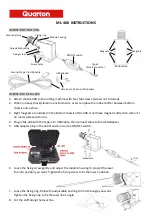
65
Chapter 3. Performance
Changing the Tuning
You can play classical styles such as Baroque using historic temperaments
(tuning methods).
Most modern songs are composed for and played in equal temperament, the
most common tuning in use today. But at one time, there were a wide
variety of other tuning systems in existence.
By playing in the temperament that was in use when a composition was
created, you can experience the sonorities of chords originally intended for
that song.
1.
Press the [Function] (Exit) button, getting its indicator to light.
2.
Press the [Song] (Select -) button or [
] () button to
display the TUNE screen.
fig.03-200d
3.
Press the [Song] (Select -) button or [
] () button to get
the Temperament setting to flash.
fig.03-250d
4.
Press the [
] (Value -) button or [
] (Value +) button to
select the temperament.
Display
Qualities
Equal
In this tuning, each octave is divided into twelve equal steps.
Every interval produces about the same amount of slight disso-
nance.
Just (Maj)
This tuning eliminates ambiguities in the fifths and thirds.
It is unsuited to playing melodies and cannot be transposed,
but is capable of beautiful sonorities.
Just (min)
The Just tunings differ from major and minor keys.
You can get the same effect with the minor scale as with the ma-
jor scale.
Kirnberger
This is an improvement of the Mean Tone and Just tunings that
provides a high degree of freedom of modulation.
Performances are possible in all keys (III).
Pythagorean
This tuning, devised by the philosopher Pythagoras, eliminates
dissonance in fourths and fifths.
Dissonance is produced by third-interval chords, but melodies
are euphonious.
Meantone
This scale makes some compromises in just intonation, en-
abling transposition to other keys.
You can save this setting in
the RG-3’s memory using the
Memory Backup function
(p. 73).
Summary of Contents for RG-3
Page 1: ... 0 4 3 4 9 3 7 8 0 1 06 08 1N 04349378 ...
Page 2: ......
Page 120: ...118 MEMO ...
Page 123: ......
















































